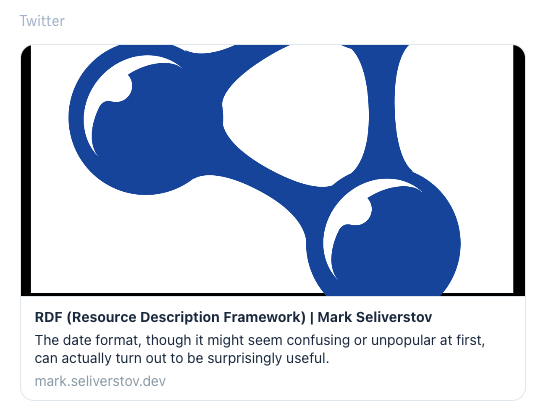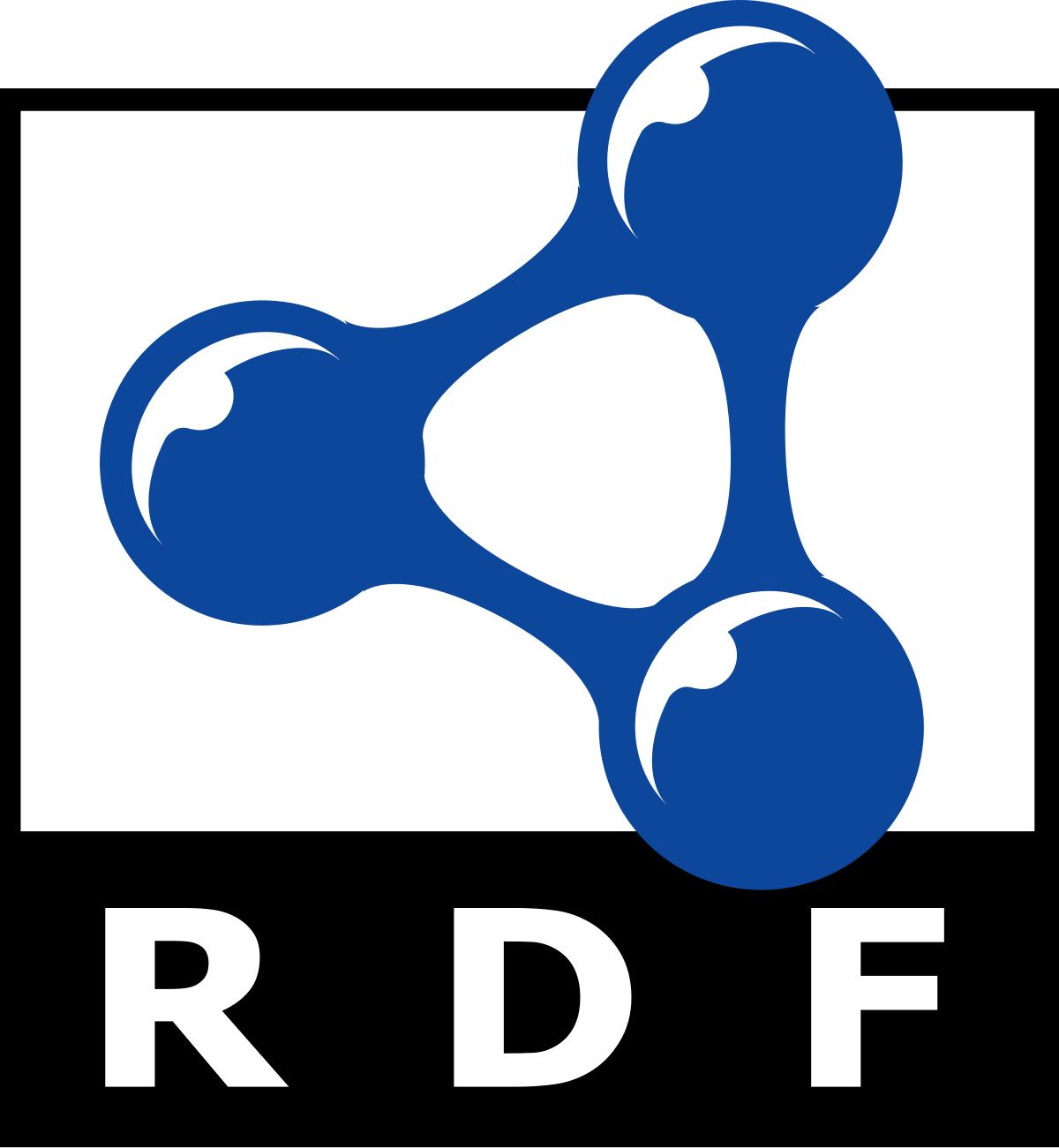- RDF - W3C
- Cool things with RDF
- Created by the World Wide Web Consortium (W3C): 2004 (RDF 1.0) and 2014 (RDF 1.1).
Introduction
By the way: Ever wonder how social media shows those nice previews when you share a link? That’s actually RDF at work! Platforms like Facebook and Twitter use Open Graph metadata, which is built using RDF in HTML. It helps them grab the right title, image, and description from the page, so your shared links look great! PS: You can check the RDF metadata using Meta Tags Toolkit.
<meta property="og:title" content="RDF (Resource Description Framework)"/>
<meta property="og:description" content="The date format, though it might seem confusing or unpopular at first, can actually turn out to be surprisingly useful."/>
<meta property="og:url" content="https://mark.seliverstov.dev/blog/rdf-data-format"/>
<meta property="og:image" content="https://mark.seliverstov.dev/assets/images/rdf-logo.png"/>
 [Open Graph visualisation of this post]
[Open Graph visualisation of this post]
Let’s compare RDF with a more familiar format, like JSON. Imagine you're working with movie data.
-
With RDF: You can represent complex relationships between entities like “director,” “actors,” “release date,” and even connect movies with awards, genres, or sequels across different datasets. RDF lets you ask smart questions like “Show me all sci-fi movies directed by Christopher Nolan after 2010,” because it understands the relationships between those data points.
-
With JSON: You can store movie data neatly, but it’s hierarchical and isolated. If you want to cross-reference data (like finding all directors who’ve won specific awards), you have to manually write logic to link data from multiple JSON files.
In short, RDF is like a smart web of linked information, while JSON is a self-contained box of data. RDF shines when you need to query and connect diverse datasets easily.
Go deeper
RDF (Resource Description Framework) is a standard model for data interchange on the Web. RDF has features that facilitate data merging even if the underlying schemas differ, and it specifically supports the evolution of schemas over time without requiring all the data consumers to be changed.
RDF Triple
RDF is based on the idea of making statements about resources (in particular web resources) in expressions of the form subject-predicate-object, known as triples. The subject denotes the resource, and the predicate denotes traits or aspects of the resource, and expresses a relationship between the subject and the object.
 [where Anna is subject, owns is predicate, and Toyota is object]
[where Anna is subject, owns is predicate, and Toyota is object]
Basic Example
# Subject Predicate Object
<http://example.org/about> <http://example.org/title> "Some Title" .
# OR with prefixes
@prefix ex: <http://example.org/> .
ex:about ex:title "Some Title" .
Relative URIs
# Implicit base
@prefix ex: <http://example.org/> .
<#document> ex:title "Some Title" . -> <http://example.org/#document> <http://example.org/title> "Some Title" .
# Explicit base
@base <http://newbase.org/> .
<#document> ex:title "Some Title" . -> <http://newbase.org/#document> <http://example.org/title> "Some Title" .
More syntax sugar
# a
# Class assignment [a is a shortcut for rdf:type or <http://www.w3.org/1999/02/22-rdf-syntax-ns#type>]
<http://example.org/about> a ex:Document . -> <http://example.org/about> <http://www.w3.org/1999/02/22-rdf-syntax-ns#type> <http://example.org/Document> .
# blank nodes
@prefix foaf: <http://xmlns.com/foaf/0.1/> .
_:alice foaf:knows _:bob .
_:bob foaf:knows _:alice .
# list
@prefix ex: <http://example.org/> .
ex:about ex:authors ("Alice" "Bob" "Charlie") .
RDF Schema (RDFS)
Schema for creating another schema. It is a vocabulary for describing properties and classes of RDF resources, with semantics for generalization-hierarchies of such properties and classes.
@prefix ex: <http://example.org/> .
@prefix rdfs: <http://www.w3.org/2000/01/rdf-schema#> .
ex:Moto a rdfs:Class .
ex:MiniMoto a rdfs:Class ; # Inheritance
rdfs:subClassOf ex:Moto .
Issues with non-linked data (CSV, JSON, etc.) or Why RDF?
- Ambibuous identification of entities in the data
- For example, "John Smith" could refer to multiple people, but in a linked data world, it would be a unique identifier.
- Low fidelity of data
- For example, "John Smith" could be a string, but in a linked data world, it would be a URI.
- No context
- For example, "John Smith" could be a name, but in a linked data world, it would be a URI with a specific context.
RDF benefits
- It is significantly easier to define big related data sets.
- It is easier to merge/maintain/update data from different sources.
- Searchin and querying is easier.
